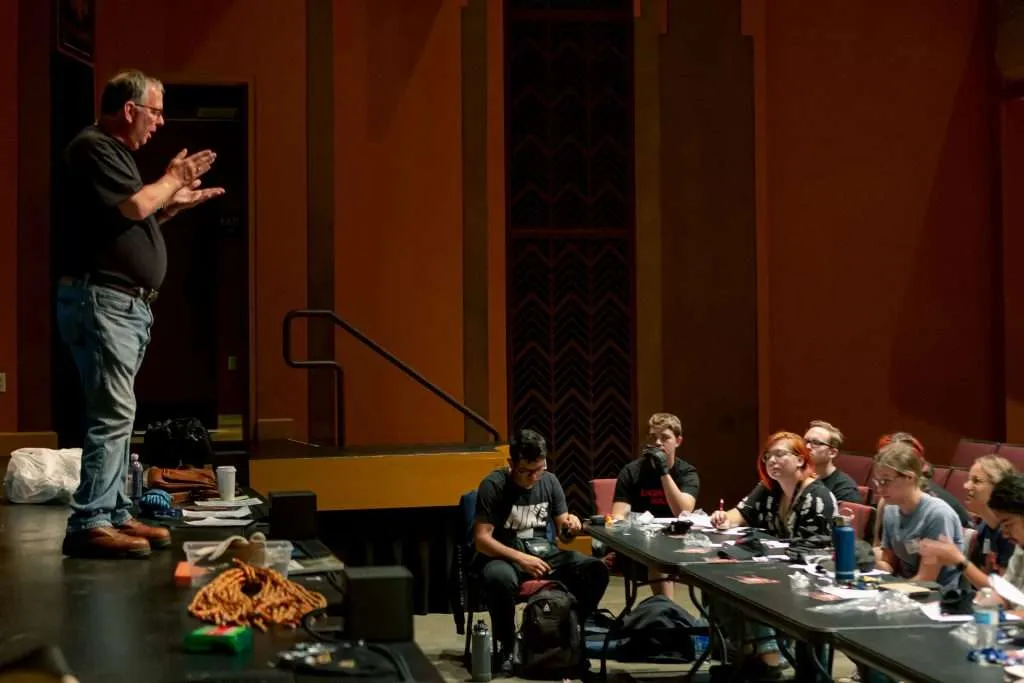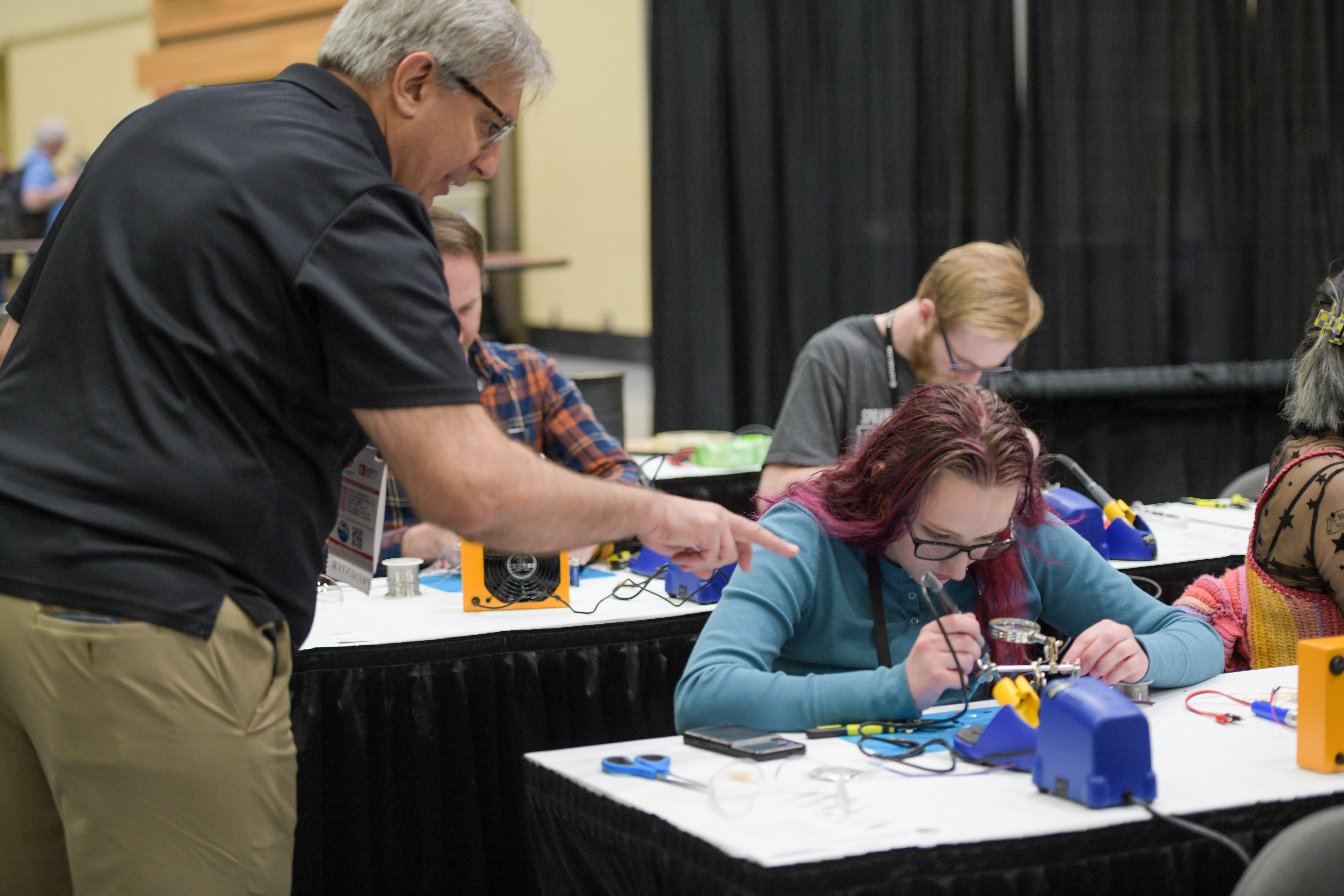Take a Dive Into Our BACKstage Exam
September 27, 2024
We chatted with USITT Board member and co-creator of the BACKstage Exam, Dana Taylor to learn more about the exam, who it benefits, what educators have been saying, and more!
Give us a general overview of the BACKstage Exam, what it entails, who the exam is for, and its purpose.
The exam covers eight technical theatre disciplines, including Audio, Lighting and Electrics, Rigging, Costume and Wardrobe, Scenic Construction, Venue, and Personnel and Safety. It is designed for high school juniors and seniors with two years of technical theatre training or experience.
The purpose of the exam is twofold. One, it is a measure of career readiness, and two, it provides instructional guidance for educators, especially those with less experience in technical theatre.
How did the idea for the BACKstage Exam come to be? Who have been some of the key players in its creation and success?
The exam started with a call I made to Beth Martell, a USITT Board member and the individual responsible for USITT’s Essential Skills for Entertainment Technicians program (eSET). I had worked on eSET when it was an ESTA program and believed the exam could be used in high schools. In my call to Beth, I asked permission to retool the exams to create a multi-disciplinary exam for high school students. She agreed to the project and the work started with five of us, initially selecting questions from the existing exams and creating new questions as needed. My co-creators are Kristi-Ross Clausen, Scott Parker, Tony Fling, and Kevin Barton Held.
The major push forward came as the result of a phone call from Jim Palmarini, at the Educational Theatre Association (EdTA). I had worked with Jim when I was technical editor for EdTA’s publications. Jim wanted to know if I wanted to help create a technical theatre exam for EdTA. I told him we had one we were creating for USITT, and the partnership began. In short, USITT had the exam, but EdTA had the students.
In addition to creating the exam, Jim, Dale Schmid, Jack Mitchell and I started working on making the exam acceptable to states where technical theatre is a CTE subject.
The committee also provided advice regarding the appropriateness of questions and whether they passed psychometric muster.
Talk to me about the Exam's partnership with EdTA. How did this relationship form and how do you collaborate on the BACKstage Exam?

EdTA had the students and we had an exam but EdTA also has a robust outreach to schools, and because they are a familiar and respected name in the secondary education community, it added credibility to what we had created. Initially guided by Jim Palmarini, the reins were passed to Cory Wilkerson, Chief Learning Officer at EdTA. With Jim, and now with Cory, we have been given numerous opportunities to talk with high school educators about the exam and its potential for both students and teachers. Finally, Jim, Cory, and EdTA assisted enormously in piloting the exam in 2020 and 2021.
What are the benefits of giving the BACKstage Exam from an educator's perspective?
First and foremost, the exam and its curricular materials provide instructional guidance for technical theatre education. By identifying what students should be learning, teachers can utilize that information as they design their curriculum.
What are the benefits of taking the BACKstage Exam from a student’s perspective?
Student empowerment and a sense of accomplishment. It is our hope that universities will acknowledge the exam as a tool for student recruitment and granting college credit for introductory courses in stagecraft or, in the absence of SAT and ACT predictors, a mechanism for scholarship awards.
We also heard from Veronica Sims Stephenson, an educator in Alabama, who said, "We were part of the pilot program last year and this year I have students thriving in tech like never before! Each tech student who competed in festivals this year earned superior rankings. Several were first in the state and one is competing at ITF this summer in two tech events."
What are the top three most important aspects of the BACKstage Exam?
It's a tool to empower students, a curricular tool for teachers, and a mechanism to recognize and highlight student/school achievement.
How has BACKstage progressed since its inception? What were your goals for it when it started and has it met those goals?
The BACKstage Exam has not changed materially since its inception but is coming due for updates and content additions. A phrase we often heard and echoed was, “game changer." I still believe that is the case but I think we have tempered our expectations in regard to the speed of that change. I do think we have accomplished our primary goal of creating a good exam that benefits both students and teachers. Our other major goal was the adoption of the exam by those states that have CTE technical theatre. So far, Washington, Arizona, and New York have done so and we have heard about some movement in that direction in California.
What feedback have you gotten from educators and students who have taken the BACKstage Exam? How have you altered the exam based on the feedback?
When we present about the exam at Thespian and USITT Conferences we hear generally positive comments. Granted, it is a test, so people don’t get really excited but
I do think it has been well received. We have made alterations to the exam but mostly on the administrative side, for example how content is delivered and the registration process.
The BACKstage Exam has been approved for use as the standard for CTE programs in at least two states and is set to be approved soon in more, talk me through that process. What does a CTE certification mean for BACKstage? What weight does it hold?
Yes, as I said earlier, we are in Washington, Arizona, and New York and have had conversations with Nevada. I just saw the exam referenced in a document for CTE education in California. I am unaware of anything we have specifically done to promote the exam to the CTE states and honestly, only discovered Arizona and Washington because someone mentioned it and New York because a school there had taken BACKstage and that opened the door to any New York school to do so.
The weight of CTE adoption is important as an indicator of work readiness but also as an acknowledgment of the real-life value of the work. In the 30 years I was in the classroom, I, and others, preached the gospel of “go to college”. I understand now, that was not necessarily true for everyone, and that vocational/trades education was of equal value.
CTE adoption also opens the door to funding from Perkins Grants from the federal government.
 What is the future of the BACKstage Exam? What can both students and educators expect as the test grows?
What is the future of the BACKstage Exam? What can both students and educators expect as the test grows?
We will be adding additional questions about scenic construction and stage management. Also, we recognize there are no questions for makeup or wigs so that needs a look as well. Perhaps most intriguing is the potential and opportunity to grow training opportunities for students and their teachers. BACKstage is a written exam that constantly references skill sets. Training is critical as we explore ways to make BACKstage more comprehensive and beneficial. So, can we get our university members, Regional Sections, or other discipline experts to offer training around the country? The USITT Midwest Regional Section offered three days of training this past summer under the banner of Midwest Educational Technical Theatre Symposium (METTS). The event attracted 37 participants who selected three sessions from five disciplines: rigging, projection, Eos console programming, scenic construction, and theatre safety and management. We were able to grant each participant 18 hours of professional development.
For universities and the IA, opportunities like these seem a reasonable method for recruitment.
Any resources you’d like to share for both educators and students?
The Technical Theatre Educators page on Facebook is a great resource. I also use JR Clancy’s iRigging App, and the One-Shot Training videos by DeLong Rigging Solutions.
What steps should educators take if they want to give the exam?
They should contact Karen Greenfield at USITT!
What steps should students take if they want to take the exam?
Review materials related to each of the disciplines found on the test. These can be found here. Also, for educators and students, make use of the terminology guides found for each discipline. There are no terms that aren’t found in the exams either directly or inferred.